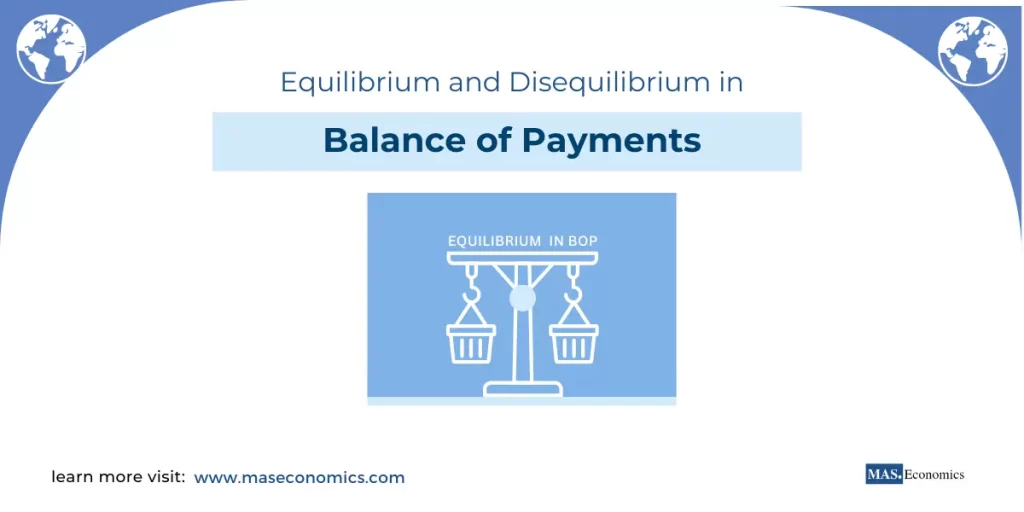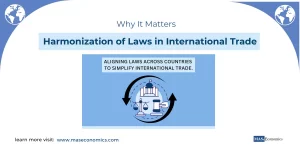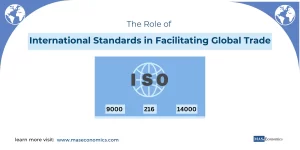The Balance of Payments (BOP) is a vital indicator of a country’s economic health, capturing all monetary transactions between residents and the rest of the world over a given period. It includes trade balances, capital flows, and financial transfers. Achieving equilibrium in the Balance of Payments is challenging due to numerous factors that influence economic stability. Concepts of equilibrium and disequilibrium in Balance of Payments, along with the causes of imbalances and the strategies policymakers use to restore balance, are key to understanding international economic health.
What is Equilibrium in Balance of Payments?
Equilibrium in Balance of Payments occurs when a country’s total financial inflows equal its total financial outflows over a specific period. This balance means that a country’s total payments for imports, investments, and other foreign expenditures are adequately met by its earnings from exports, foreign investments, and other income sources.
Understanding BOP Equilibrium
Achieving equilibrium means there are no unintended accumulations or depletions of foreign reserves. In simpler terms, a country neither experiences a deficit (a shortage in foreign reserves) nor a surplus (an excessive accumulation of foreign reserves) over time. It indicates that the country’s economic transactions are balanced and no drastic corrective measures are required.
However, equilibrium is a theoretical ideal rather than a constant reality. Due to the volatile nature of global trade, fluctuations in foreign direct investments (FDI), and changing consumption patterns, countries often find themselves in a state of disequilibrium.
Disequilibrium in Balance of Payments: Causes and Types
Disequilibrium in Balance of Payments arises when a country’s total payments to foreign countries do not equal its total receipts. Such a condition can lead to BOP deficits or surpluses.
Types of Disequilibrium
1. BOP Deficit
A BOP deficit occurs when a country’s payments exceed its receipts. In this situation, the country’s foreign currency outflows are greater than its inflows, which can lead to a depletion of foreign reserves. Persistent deficits may force countries to borrow from international institutions or take corrective actions like devaluation of the national currency.
2. BOP Surplus
A BOP surplus means that a country’s receipts exceed its payments, resulting in an accumulation of foreign reserves. While surpluses may seem beneficial, they can indicate that a country is over-relying on exports or that domestic consumption and investment are being restricted.
Causes of Disequilibrium in BOP
Disequilibrium in BOP can be triggered by several factors, often interconnected. Understanding these causes helps in formulating effective policies to correct imbalances.
Changes in Global Demand
A decline in global demand for a country’s exports can result in lower receipts from international trade, leading to a BOP deficit. For instance, if global demand for a country’s primary export commodity declines, it will have fewer earnings to offset its import expenditure.
Exchange Rate Fluctuations
Fluctuations in the exchange rate significantly impact a country’s BOP. An overvalued currency can make a country’s exports more expensive and imports cheaper, leading to increased imports and declining exports. This imbalance contributes to a BOP deficit.
Conversely, an undervalued currency can boost exports by making them cheaper for foreign buyers, potentially leading to a BOP surplus if not managed properly.
Inflation Differentials
A country experiencing higher inflation compared to its trading partners will find that its exports become relatively more expensive, reducing its competitiveness. At the same time, imports become cheaper, resulting in increased import volumes. These dynamics can lead to a BOP deficit due to a loss in international competitiveness.
Structural Problems
Sometimes, disequilibrium is due to structural problems in the economy, such as underdeveloped industries, reliance on a narrow range of exports, or an inefficient production system. Such structural limitations make it difficult for a country to compete globally, leading to recurring BOP deficits.
Speculative Capital Movements
Sudden changes in speculative capital flows can lead to significant disequilibrium. Investors may pull out investments based on perceived risks or opportunities, leading to capital flight. When foreign investors sell domestic assets and convert proceeds into foreign currency, it can deplete the foreign exchange reserves, leading to a BOP deficit.
Excessive Borrowing and Debt Servicing
Developing countries often borrow from international markets or institutions to finance economic development. However, excessive external debt can lead to increased debt servicing costs, which could result in a BOP deficit if these outflows outweigh earnings from exports or other receipts.
Solutions to Correct Disequilibrium in BOP
Restoring equilibrium in BOP requires targeted policies and economic adjustments. Here are some of the common solutions:
Exchange Rate Adjustment
One of the most common solutions to correct a BOP deficit is to adjust the exchange rate. Devaluation of the national currency makes exports cheaper and imports more expensive, thereby encouraging exports and discouraging imports. For countries with a BOP surplus, currency revaluation can help bring the balance back by making imports cheaper and exports more costly.
Demand Management Policies
To correct BOP disequilibrium, policymakers may adopt monetary and fiscal policies to manage demand:
Contractionary Fiscal Policy: This involves reducing government spending or increasing taxes to reduce overall demand, thereby reducing import expenditure.
Contractionary Monetary Policy: By increasing interest rates, consumption and investment are curtailed, thereby reducing the demand for imports.
These measures are particularly effective in reducing a BOP deficit.
Import Restrictions
Import restrictions, such as tariffs and quotas, can help reduce a BOP deficit by decreasing the volume of imported goods. However, import restrictions can lead to retaliatory trade measures by trading partners and may not always be a sustainable solution.
Export Promotion Strategies
Countries can also focus on export promotion to restore equilibrium. This could involve providing subsidies to export industries, enhancing product quality, or seeking new markets for existing products. Export diversification is especially important for countries that are heavily reliant on a narrow range of commodities.
Attracting Foreign Investment
To counter a BOP deficit, countries often focus on attracting foreign direct investments (FDI) and portfolio investments. By creating a favorable environment for investors through tax breaks, reduced regulation, and improved infrastructure, a country can improve its financial account, which can compensate for a current account deficit.
Real-World Example
India is a country that has faced persistent BOP disequilibrium several times in its economic history. During the 1991 economic crisis, India experienced severe BOP deficits, mainly due to rising oil prices, excessive import demand, and a lack of foreign currency reserves.
Corrective Actions Taken:
Devaluation of the Indian Rupee: The government devalued the rupee to make exports cheaper and more competitive, which helped increase foreign exchange inflows.
Structural Reforms: The government also initiated liberalization measures, reducing tariffs, and promoting FDI, which helped attract foreign capital and stabilize the BOP.
Exchange Control Relaxation: Relaxing restrictions on foreign exchange allowed for more flexibility and improved confidence among investors and trading partners.
These measures collectively helped India transition from a BOP deficit to a more stable position, highlighting the importance of strategic policy interventions in managing disequilibrium.
Conclusion
Equilibrium and disequilibrium in Balance of Payments are crucial indicators of a country’s economic health and its sustainability in international trade. While equilibrium is ideal, disequilibrium often arises from structural, cyclical, or speculative factors. Policymakers employ tools such as exchange rate adjustments, demand management, and export promotion to correct these imbalances.
Understanding equilibrium and disequilibrium in Balance of Payments provides valuable insights into a country’s economic policies and overall stability. Maintaining this balance requires adaptability, as effective adjustments are necessary to support both domestic stability and international credibility.
FAQs:
What is equilibrium in the Balance of Payments (BOP)?
Equilibrium in the Balance of Payments occurs when a country’s total financial inflows match its total outflows over a given period, indicating balanced economic transactions without significant accumulation or depletion of foreign reserves.
What causes disequilibrium in the Balance of Payments?
Disequilibrium arises when total payments to foreign entities do not equal total receipts, leading to a deficit (outflows exceeding inflows) or a surplus (inflows exceeding outflows). Common causes include changes in global demand, exchange rate fluctuations, inflation differences, structural economic issues, and speculative capital movements.
How does a BOP deficit impact a country’s economy?
A BOP deficit depletes foreign reserves as the country pays more to foreign entities than it earns. Persistent deficits may lead to reliance on foreign borrowing, currency devaluation, or corrective policy measures to restore balance.
What factors contribute to a BOP surplus?
A BOP surplus occurs when a country’s foreign currency inflows exceed its outflows, often due to high export revenues, undervalued currency boosting exports, or large inflows from foreign investments. While beneficial in the short term, persistent surpluses can indicate over-reliance on exports or restrained domestic consumption.
How do exchange rate changes influence BOP disequilibrium?
An overvalued currency makes exports more expensive and imports cheaper, worsening a BOP deficit. Conversely, an undervalued currency boosts exports by making them more competitive internationally, potentially leading to a surplus.
Why is inflation a critical factor in BOP imbalances?
Higher domestic inflation reduces export competitiveness by making goods more expensive for foreign buyers. It also encourages cheaper imports, leading to a BOP deficit as imports exceed exports.
What strategies can correct a BOP deficit?
Exchange rate adjustments, such as currency devaluation, encourage exports and reduce imports. Fiscal and monetary tightening can manage domestic demand, while import restrictions and export promotion strategies can directly address imbalances by altering trade flows.
How does export promotion help achieve BOP equilibrium?
Export promotion increases foreign currency inflows by improving product competitiveness and finding new markets. Diversification of exports can reduce dependency on a narrow range of goods, stabilizing the current account and supporting overall BOP equilibrium.
Thanks for reading! Share this with friends and spread the knowledge if you found it helpful.
Happy learning with MASEconomics




